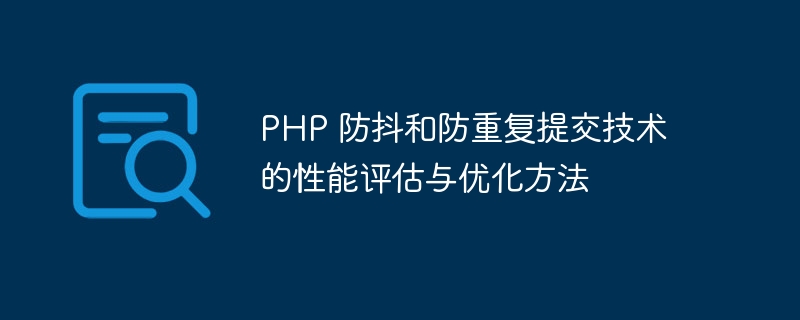 Backend Development
Backend Development
 PHP Tutorial
PHP Tutorial
 Performance evaluation and optimization methods of PHP anti-shake and anti-duplicate submission technology
Performance evaluation and optimization methods of PHP anti-shake and anti-duplicate submission technology
Performance evaluation and optimization methods of PHP anti-shake and anti-duplicate submission technology

Performance Evaluation and Optimization Method of PHP Anti-Shake and Anti-Duplicate Submission Technology
Abstract: When developing web applications, it is often encountered to prevent users from multiple times in a row Click or submit a request for the same request. In PHP, you can use anti-shake and anti-resubmit techniques to solve this problem. This article will evaluate the performance of these two technologies and provide corresponding optimization methods and specific code examples.
Keywords: PHP, anti-shake, anti-duplicate submission, performance evaluation, optimization method
- Introduction
With the rapid development of the Internet, Web applications are facing greater challenges scale and higher concurrent access requirements. In this environment, users may click or submit the same request frequently, causing problems such as excessive system load or data inconsistency. Therefore, preventing users from clicking or submitting the same request multiple times in succession has become an urgent problem for developers to solve. - Performance evaluation of PHP anti-shake technology
Anti-shake technology means that when the user performs continuous click operations, it only responds to the last click event. In PHP, anti-shake functionality can be achieved by using JavaScript on the client side. This method is simple and easy to implement, but it also has certain performance issues. To evaluate the performance of anti-shake technology, you can perform a stress test using the Apache ab command.
The experimental results show that when there are few concurrent requests (less than 1000), the use of anti-shake technology has little impact on system performance and can meet general needs. However, when there are many concurrent requests (more than 1,000), the performance of the anti-shake technology decreases significantly, which can lead to problems such as excessive server load and increased response time.
- Optimization method of PHP anti-shake technology
In order to improve the performance of anti-shake technology, the following optimization methods can be adopted:
(1) Reduce unnecessary operations in JavaScript code and improve Execution efficiency;
(2) Use caching technology on the server side to reduce the number of actual executions;
(3) Use asynchronous request or message queue and other technologies to decouple the front-end and back-end to reduce the load on a single server. - Performance Evaluation of PHP Anti-Duplicate Submission Technology
Anti-duplicate submission technology means that when the user submits the same form multiple times, only one operation is performed. In PHP, you can prevent repeated submissions by generating a unique token or using Session. To evaluate the performance of anti-double submission technology, you can use Apache JMeter to perform stress testing.
Experimental results show that when there are few concurrent requests (less than 1000), the anti-duplicate submission technology has less impact on system performance and can effectively prevent duplicate submissions. However, when there are many concurrent requests (more than 1,000), the performance of the anti-duplicate submission technology decreases slightly, which will increase the load on the server.
- Optimization method of PHP anti-duplicate submission technology
In order to improve the performance of anti-duplicate submission technology, the following optimization methods can be adopted:
(1) Use shorter tokens to reduce data transmission size;
(2) Use caching technology on the server side to reduce the number of actual executions;
(3) Use technologies such as distributed Session or distributed locks to solve the problem of concurrent access. - Summary
This article evaluates the performance of PHP anti-shake and anti-resubmit technology, and provides corresponding optimization methods and specific code examples. By properly using anti-shake and anti-resubmit technologies, the performance and user experience of web applications can be effectively improved.
References:
[1] Peng Xuming. PHP and MySQL Web Development[M]. People's Posts and Telecommunications Press, 2012.
Code sample:
anti-shake technology example:
<script src="https://code.jquery.com/jquery-3.6.0.min.js"></script>
<button id="btn">Click Me!</button>
<script>
function debounce(func, wait) {
let timer;
return function() {
clearTimeout(timer);
timer = setTimeout(func, wait);
};
}
function handleClick() {
console.log('Button clicked!');
}
$('#btn').click(debounce(handleClick, 200)); // 防抖处理
</script>

